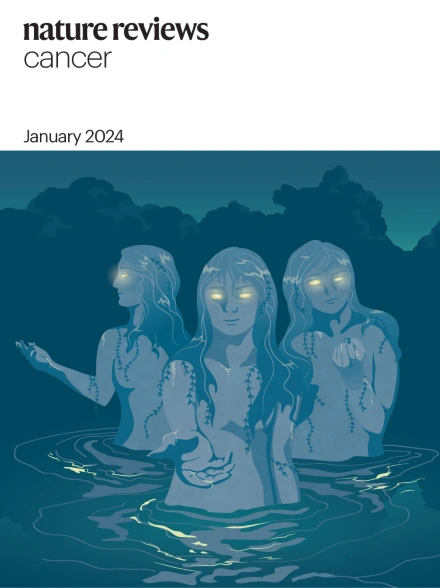基质衰老会导致癌症与年龄相关的增加。
IF 66.8
1区 医学
Q1 ONCOLOGY
引用次数: 0
摘要
衰老是一个以一系列细胞和系统变化为特征的过程,这些变化共同增加了患癌症的风险。虽然早期肿瘤细胞内的细胞自主突变很重要,但微环境中与年龄相关的变化是转化过程和治疗反应的关键伙伴。然而,衰老的一些重要方面以及它们对癌症的影响程度仍不清楚。影响衰老的因素之一是细胞衰老增加,但重要的是要注意,衰老和细胞衰老不是同义词。我们强调了一些悬而未决的问题,包括衰老细胞是否在老年组织和年轻组织中具有不同的表型影响,或者是否是细胞类型决定了衰老对组织稳态和疾病的影响。最后,很可能我们目前对细胞衰老的定义包含了不止一种不同的细胞状态;因此,我们强调了在细胞类型和起源组织中已经注意到的表型差异。这篇综述的重点是衰老间质细胞在癌症中的作用,鉴于对成纤维细胞的大量研究,特别强调成纤维细胞。本文章由计算机程序翻译,如有差异,请以英文原文为准。

Stromal senescence contributes to age-related increases in cancer
Ageing is a process characterized by a wide array of cellular and systemic changes that together increase the risk of developing cancer. While cell-autonomous mutations within incipient tumour cells are important, age-related changes in the microenvironment are critical partners in the transformation process and response to therapy. However, aspects of ageing that are important and the degree to which they contribute to cancer remain obscure. One of the factors that impacts ageing is increased cellular senescence but it is important to note that ageing and cellular senescence are not synonymous. We highlight open questions, including if senescent cells have phenotypically distinct impacts in aged versus young tissue, or if it is the cell type that dictates the impact of senescence on tissue homeostasis and disease. Finally, it is probable that our current definition of cellular senescence encompasses more than one mechanistically distinct cellular state; thus, we highlight phenotypic differences that have been noted across cell types and tissues of origin. This Review focuses on the role that senescent stromal cells have in cancer, with a particular emphasis on fibroblasts given the amount of work that has focused on them. Ageing influences cancer risk through cellular and environmental changes, including the induction of cellular senescence. In this Review, Ye, Melam and Stewart highlight the role of senescent stromal cells in cancer and the therapeutic implications of this.
求助全文
通过发布文献求助,成功后即可免费获取论文全文。
去求助
来源期刊

Nature Reviews Cancer
医学-肿瘤学
CiteScore
111.90
自引率
0.40%
发文量
97
审稿时长
6-12 weeks
期刊介绍:
Nature Reviews Cancer, a part of the Nature Reviews portfolio of journals, aims to be the premier source of reviews and commentaries for the scientific communities it serves. The correct abbreviation for abstracting and indexing purposes is Nat. Rev. Cancer. The international standard serial numbers (ISSN) for Nature Reviews Cancer are 1474-175X (print) and 1474-1768 (online). Unlike other journals, Nature Reviews Cancer does not have an external editorial board. Instead, all editorial decisions are made by a team of full-time professional editors who are PhD-level scientists. The journal publishes Research Highlights, Comments, Reviews, and Perspectives relevant to cancer researchers, ensuring that the articles reach the widest possible audience due to their broad scope.
 求助内容:
求助内容: 应助结果提醒方式:
应助结果提醒方式:


